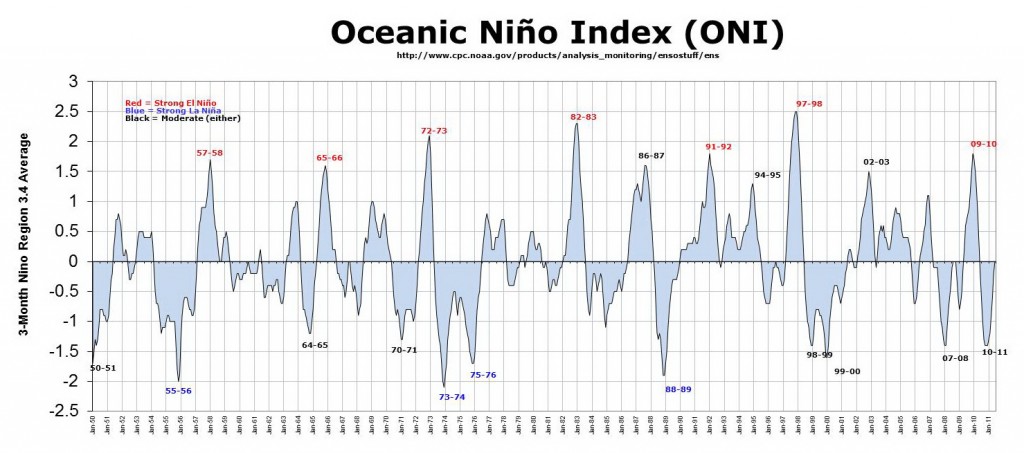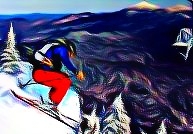Well the time has come for the LionelHutz official 2011-2012 winter outlook. I put a lot of work into this and I hope you enjoy it.
So let’s get right down to it with some opening remarks about the overall prevailing conditions I expect to see. I’m going to consider three major large scale conditions, La Nina, the NAO, and the PDO. These are macro weather patterns that effect the entire country’s weather (and in truth much of the Earth’s weather) and therefore must be examined in order to make a reasonable winter outlook.
1. La Nina
First and foremost this year will see La Nina conditions prevail in the Equatorial Pacific. Remember, La Nina means the sea surface temperatures in a certain part of the ocean are cooler than normal; El Nino means those same waters are warmer. You know what would actually make this pretty clear…AN MSPAINT MAP!!!
Although it may not seem like it, these departures from average thousands of miles from here have impacts on our seasonal weather and many would argue it’s the single biggest contributor to the sensible weather we’ll see this winter.
After much hemming and hawing this summer about where last year’s la Nina was heading, and a period where it really looked we where headed to the dreaded “La Nada,”(i.e. neither a nina or nino) it’s clear that this winter will be a La Nina winter and likely a “moderate” la nina winter. (Ninas and Ninos are classified as moderate, strong or weak depending on the sea temperatures departure from normal). If you recall last winter was also a moderate La Nina winter. This bears heavily into our analog year comparisons, because the “double dip” La Nina -i.e. two back to back la Ninas – is not common. Look:
As you can see, the last double dip was 2007-08 – 2008-09 and as you’ll read below, I believe 2008-2009 will be a great comparison to this winter. Other double dip years are 56-57, 72-73, 75-76, 99-00. Of these, 75-76, 99-00 and the aforementioned 08-09 seasons followed moderate La Ninas like this year. So when looking at la Nina years for comparisons, lean towards the SECOND la nina year as being more a more favored comparison.
2: NAO
Secondly, while la Nina is a great tool to assess the overall large scale pattern, the sensible weather in the northeast is also effected strongly by smaller scale teleconnections such as the Arctic Oscillation (“AO”), the Pacific North American Pattern (“PNA”), and the North Atlantic Oscillation (“NAO”). Of these the NAO is probably the most well known and may have the greatest effect on the weather in the northeast. A negative NAO pattern favors below average heights (AKA cold weather) across the northeast. Last season, we saw this play out to the extreme as the VERY strongly negative NAO dominated and displaced cold air where it wasn’t expected. (See the sustained six week stretch of dead winter from Jan 1 to Feb. 15.) In a La Nina pattern that sustained cold throughout the northeast is VERY uncommon. While the NAO is subject to much greater variability than the ENSO state, we’ve been in a strongly negative NAO pattern for several seasons now and so I’m confident we’ll trend in that direction this winter.
3: PDO
There is a large, multi-year pattern called the Pacific Decadal Oscillation (“PDO”). Essentially the PDO is a measure of north pacific sea surface temperatures and unlike La Nina or El Nino it’s a very long lasting pattern. In the cool phase it has been shown to enhance the effects of a La Nina pattern, enhance precip in the northwest/west, great lakes, and increase temperatures in the southeastern US. There is still a lot of science work being done on this pattern but I think it is very important to our weather. We’ve been in the cool phase for a while now and thus to really look at analog years you have to weigh years with the negative PDO pattern more heavily. Hence why I think looking at 2007-008 and 2008-2009 with the latter being weighted more, is the best play. I mean I’ve certainly incorporated ALL the analog years I could find in making this forecast, but sometimes you can get information overload and analysis paralysis. That’s really common with weather where there are countless variables, teleconnection indices and past weather data to look at.
So lets put some of this together using data from 2007-2008 and 2008-2009 as I think those are the best analog years with extra weight given to 2008-2009 under the double dip theory.
Northeast:
Lets take a gander at the snowfall from those years. We’ll use the Mt. Mansfield stake, J-Spin’s REALLY in-depth data collected in Waterbury, VT, and Mt. Washington data.
Looking at some analog years for the Mansfield Stake (yes I went past my 2007-2009 rules but it had to be done because of the inaccuracy of the Manny stake) we see the following for total snow depth:
and this is what we see for how that snow fell:
So excluding the “56-57 wtf was the weather thingy broken” year, we see similar years having average to above average snowfall. Interestingly in looking at how that snow fell we see clear spikes in storm size in December and February. Good to know.
Now lets turn to another GREAT data source. My man Jay keeps a snow reporting station with super accurate records at his place in Waterbury VT. While not perfect for measuring snowfall a few thousand feet up, over the years I’ve found it to be pretty damn accurate, albeit a bit low, for approximating the snow fall in the Northern Greens (and to a lesser but still reasonable extent) snowfall in the ADK.
So lets start with 2007-2008. This season was marked with a HUGE December (67.2 inches) and BIG February (54.7 inches) with an above average November (18 inches) and average March (33.3 -repeating of course- inches). The season hit its low point in January with a measly 27.6 inches of snow. Looking more closely at how this snow fell, we see the 5 biggest events as follows (these links loop weather maps of the events occurring so you can see the storms’ dynamics):
1. 19.2 inches (12/3/07-12/6/07)
2. 16.5 inches (12/16/07-12/17/08)
3. 16.4 inches (2/6/08-2/8/08)
4. 10.6 inches (1/1/08-1/2/08)
5. 10.2 inches (3/19/08-3/21/08)
With 53 snowfall “events” over all,roughly one measurable snowfall every 3 days, the season produced a grand total of 203 inches in Waterbury. Pretty damn good.
2008-2009 was another good year but overall not as great as 2007-2008. 176.6 inches of snow fell in 43 snowfall events. With 163 days of measurable snow on the ground, that’s roughly a snowfall event once every 4 days. Interestingly the season was marked with another very large December (55.9 inches) and above average November (20 inches). However instead of a large February, 2008-2009 featured a a snowy January (50 inches) and also saw a very un-snowy march. EVEN MORE interesting is how the snow fell.
See the biggest events were:
1. 18.2 inches (2/22/09-2/24/09)
2. 15.2 inches (2/18/09-2/21/09)
3. 14.2 inches (11/20/08-11/23/08)
4. 13.4 inches (12/21/08-12/22/08)
5. 11.8 inches (1/28/09)
…and from 12/11 to 12/22 (Part 1, Part 2 and Part 3) almost 40 inches fell in a 10 day span with a weak warm-up in between.
So really when you look at it, you had one hell of an awesome 10 day stretch in December, and a 40 inch week in February, with another 90 inches spread over like 140 days. This stands in contrast a bit to 2007-2008 which had more events, fewer BIG weeks, and more steady pow accumulation. I think a blend of these patterns is in order.
The next thing I’m considering is how these events transpired. To do that I pulled the National Re-Analysis loops from PSU’s most excellent E-Wall and looked at all the storms from 2007-2009. (You can follow along by clicking the links in the above storms)
What did I see? Well mainly I saw two types of systems. First I saw a number of strong lows ride along a boundary that draped across central New England and spread snow and mixed precip into NE, with back-side upslope snows accounting for the biggest portion of the total snowfall. Secondly I saw a few upper level troughs that hung around and just used moisture, weak upper level divergence and lifting, along with orographics to produce steady snow for 10 days straight. I saw few coastal nor’easters and quite a few nasty “lakes cutters” and “dirty ridges.”
Just for kicks I also took a look at MTW’s recorded data. Here is what it told me: December 2007 and December 2008 were good snowfall months. February 2008 and 2009 were average with around 4 feet of snow each month. The rest of the seasons saw below average snowfall and average temps. The exceptions being Jan. 2008 which was just WARM on the rockpile.
Utah (and sorta the PacNW):
Wait – you thought I was limiting this to only the Northeast? Heck no! I find the weather in the Cottonwood Canyons in Utah infinitely awesome and compelling. And given that we have a leading operative based there, I can’t ignore it.
Using Alta as a proxy for the high Cottonwoods overall snowfall situation lets consider 2007-2008 and see what we see.
In 2007, Alta had a 701 inch season. Ho-Hum. BY month the totals were: October, 53, November 24, December 140, January 179, February 104, March 93, April 92.
Notable large snowfall events that season were as follows: 40 from 12/7 to 12/8, 40.5 from 12/18 to 12/21, 36 from 12/28-12/31, 27.5 from 1/7 to 1/8, 50 from 1/27-1/30, 40 from 2/1- 2/4.
Now, lets look at 2008-2009 where Alta had a 696 inch season. Excuse me while I kiss the sky. Monthly totals were 76 in November, 116 in December, 119 in January, 98 in February, 141 in March and 156 in April. Notable events were:
50 from 11/3 to 11/5, 50 from 12/22-12/26, 45 from 1/2 to 1/6, 40 from 1/24-1/26, 30 from 2/16 to 2/18, 68 from 3/22 to 3/26, 30 from 3/28 to 3/30, 50 from 4/1 – 4/4 and 40 from 4/15 to 4/16.
In looking at these systems I notice a few things. 1, the “big” storms occurred in a pretty similar synoptic set up nation-wide and were rather consistent in their density and duration. The major difference I noticed was that there were BIGGER events in 2008-2009, but also bigger gaps between the events. In 2007-2008 I saw a lot more steady snowfall with fewer “big” events. (Note if you ever hear me say “storm cycle” or “storm train” please punch me in the throat. Sometime this winter I’ll get around to explaining why I hate these terms). Given how I like 2008-2009 more, lets store this nugget in our pockets.
In other analog years I looked at there was a spread of total of snowfall. Several analog years saw substantially below average snowfall, while others saw above average snowfall. Given that Utah in general sees some of the lowest variability in snowfall from year to year and from the change from el nino to la nina you can only assume that the real low years were simply statistical outliers and not really indicative of some hidden pattern I can’t see. Of course I could be wrong, but the topography, location and simple mechanics of snow all say Utah shouldn’t get skunked. Like ever.
I also took a quick look at Mt. Baker Snowfall in 2007-2008 and 2008-2009. Yea…not too exciting.
So what does this all mean? Read on young padawan and yee shall see…
13 Comments
Leave a Reply
|
|||
| Home |







Josh A
wrote on October 9th, 2011 at 9:07 pmThanks for the great in depth analyses. It was informative and educational.
So, basically us Vermonters should be thinking of planning a trip to UT in January?
icelanticskier
wrote on October 9th, 2011 at 11:17 pmhmmmmmm, maybe another winter ’07 for us. c’mon valentines WEEK blizzard, c’mon!
rog
Lionel Hutz
wrote on October 10th, 2011 at 6:11 amThat was the winter of 2006-2007. Not an analog.
icelanticskier
wrote on October 10th, 2011 at 10:56 amexplain.^^^^^^^^^^^^^^^^please.
rog
Lionel Hutz
wrote on October 10th, 2011 at 11:16 amNot to get bogged down here but this is pretty simple. The “Valentines Day” nor’easter occurred 2/13-15, 2007. Loop here: http://www.meteo.psu.edu/~gadomski/NARR/2007/us0214j3.php
That’s regarded as being in the 2006-2007 WINTER SEASON. When I use analog years- as do most weatherman- we use the winter season i.e. Nov. Year 1 thru March of the next year. As you can see the ENSO state for 06-07 was an weak to moderate El-Nino following a weak to moderate nina. Moreover the NAO pattern at that time was more positive or at least neutral. These factors are not present this season so 2006-2007 is not an analog year.
MadPatSki
wrote on October 10th, 2011 at 12:26 pmThanks Lionel,
The only thing of concern is that warm weather for October turns. Maybe I should have driving to Mt. Miller this weekend. :)
Keep up the good work.
I'm_a_crappy_skier
wrote on October 10th, 2011 at 2:55 pmLH, that was the best 20 min I spent reading all day! Thank you! Got gortex for the slop and got snows for the ride when awesomeness prevails (just no studs :-(
Can you supply ready-made boss-proof fibs for sick days too with your prognostications (I use big fancy words to make up for my lack of skiing ability…)
Anonymous
wrote on October 12th, 2011 at 11:37 amthat’s a GREAT idea… I’d love to see what the man LH could come up with too. Undoubtedly some useful ones and some HILARIOUS ones XD
Jtran10
wrote on October 10th, 2011 at 3:11 pmThanks LH, very informative
icelanticskier
wrote on October 10th, 2011 at 3:47 pmthanx LH. i did mean 06/07, but didn’t feel the need to add the 06 to the 07 as the storm hit in 07. boy and i thought greg wuz a nit-picky little bastid!:)
rog
savant
wrote on October 11th, 2011 at 1:26 pmwe all hope you’re right LH -thanks
powhounddd
wrote on April 25th, 2012 at 12:09 pmInteresting to re-read this now. Always appreciated, and this had some things downright dead-on… what a weird winter.
Joann
wrote on August 16th, 2012 at 3:32 pmThanks Lionel, I’ll echo the sentiments this was my favorite read of the day, especially that part about the elevations in the Adks doing very well…